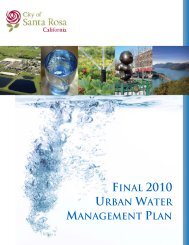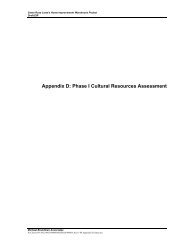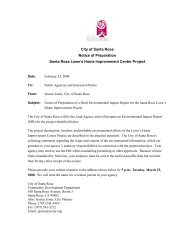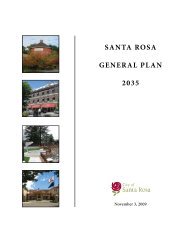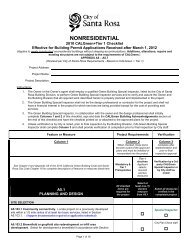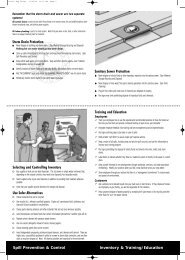Fountaingrove Environmental Impact Report - City of Santa Rosa ...
Fountaingrove Environmental Impact Report - City of Santa Rosa ...
Fountaingrove Environmental Impact Report - City of Santa Rosa ...
You also want an ePaper? Increase the reach of your titles
YUMPU automatically turns print PDFs into web optimized ePapers that Google loves.
4.0 MITIGATION MONITORING AND REPORTING PROGRAM<br />
TABLE 4-1<br />
Mitigation Monitoring and <strong>Report</strong>ing Program<br />
Documentation<br />
Additional Permit<br />
Enforcement<br />
Implementation<br />
Schedule<br />
<strong>Impact</strong>s Mitigation Measures Responsible<br />
Party<br />
during construction shall be relocated by a qualified<br />
biologist outside the construction zone limits. This<br />
mitigation requirement shall be noted on improvement<br />
plans, grading plans, and building plans.<br />
N/A Project plans to include biological<br />
monitor provision.<br />
During<br />
development <strong>of</strong><br />
design plans.<br />
Mitigation Measure 3.4-5b: Perform onsite monitoring<br />
during construction.<br />
Daily logs and monthly compliance<br />
reports.<br />
<strong>City</strong> <strong>of</strong> <strong>Santa</strong><br />
<strong>Rosa</strong><br />
Department <strong>of</strong><br />
Community<br />
Development<br />
During<br />
construction to<br />
the satisfaction<br />
<strong>of</strong> the<br />
Department <strong>of</strong><br />
Community<br />
Development.<br />
Qualified<br />
Biologist<br />
Biological monitors shall be employed to monitor and/or<br />
implement construction mitigation measures and to report<br />
on compliance with mitigation measures by contractors.<br />
Biological monitors shall be qualified to conduct the<br />
mitigation activities described herein as well as additional<br />
mitigation that may be required in project permits. <strong>Report</strong>s<br />
on noncompliance with environmental requirements may<br />
result in temporary halting <strong>of</strong> construction activity to<br />
examine the noncompliance and prevent further resource<br />
damage. Biological monitors shall:<br />
• Provide worker environmental awareness training<br />
for all construction personnel that identifies sensitive<br />
biological resources that may occur in or adjacent to<br />
construction areas and that addresses measures<br />
required to minimize Project impacts during<br />
construction and operation.<br />
• Designate a setback from the creek in the Project<br />
plans. This setback will be identified by orange<br />
construction fencing installed before construction<br />
activities onsite. A biological monitor will monitor the<br />
installation <strong>of</strong> the construction fencing.<br />
• Be present onsite during initial construction activities<br />
to identify sensitive resources.<br />
• Monitor mitigation construction near sensitive<br />
habitats and resources.<br />
• Prohibit ground disturbance until sensitive areas are<br />
cleared.<br />
• Be present during open trench work construction<br />
activities that require special attention in sensitive<br />
areas.<br />
Prepare construction monitoring and compliance reports<br />
that analyze the effectiveness <strong>of</strong> the mitigation measures.<br />
3.5 Cultural Resources<br />
Project plans and specifications revised<br />
to include provisions for archaeological<br />
remains discovery.<br />
California Public<br />
Resources Code<br />
Sections 5024.1, 7050.5,<br />
and 5097.94.<br />
During<br />
development <strong>of</strong><br />
plans and<br />
specification.<br />
Mitigation Measure 3.5-1a: Protect historic or<br />
archaeological resources discovered during<br />
construction.<br />
<strong>Impact</strong> 3.5-1: Construction <strong>of</strong> the Project could cause a substantial adverse change in the<br />
significance <strong>of</strong> an unknown historic or archaeological resource or disturb human remains.<br />
Daily logs and monthly compliance<br />
reports.<br />
<strong>City</strong> <strong>of</strong> <strong>Santa</strong><br />
<strong>Rosa</strong><br />
Department <strong>of</strong><br />
Community<br />
Development<br />
During<br />
construction.<br />
Archaeological<br />
Monitor<br />
If archaeological remains are uncovered during<br />
construction activities, work onsite shall be halted<br />
immediately until a qualified archaeologist can evaluate<br />
the finds. Project personnel shall not alter any <strong>of</strong> the<br />
uncovered materials or their context. If resources are<br />
encountered, the Project applicant, in consultation with a<br />
qualified archaeologist, shall prepare a resource<br />
inventory, declaration, and mitigation plan and shall<br />
submit it to the <strong>City</strong> for review and approval prior to the<br />
continuation <strong>of</strong> construction activities. Prehistoric<br />
archaeological site indicators include obsidian and chert<br />
flakes and chipped stone tools, grinding and mashing<br />
Because a high potential exists for cultural resources to occur given the site conditions,<br />
potential impacts could occur to unknown subsurface cultural resources during construction.<br />
With implementation <strong>of</strong> Mitigation Measures 3.5-1a and 3.5-1b, potential impacts to cultural<br />
resources would be less than significant.<br />
implements (e.g., slabs and handstones, mortars and<br />
4-8 ES092008001PHX\ BAO\082970001



